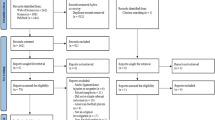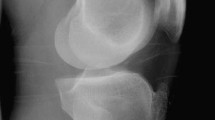Abstract
Introduction
This study aimed to assess the reliability and validity of the modified McGowan grading system and to determine its ability to distinguish the severity of cubital tunnel syndrome (CuTS) between the different grades.
Materials and methods
We prospectively enrolled 39 consecutive patients with CuTS from March 2018 to December 2020. Inter- and intra-observer reliability was assessed by two orthopaedic surgeons with a minimum 2-week interval using Cohen kappa coefficients. Validity was assessed by Spearman’s correlation with objective clinical outcomes (grip strength, Semmes–Weinstein monofilament test [SWMT], static two-point discrimination [2PD], and motor conduction velocity [MCV]). In addition, the relationship between the grading system and patient-reported outcomes (Disabilities of the Arm, Shoulder and Hand score and Boston Questionnaire) was evaluated using Spearman’s correlation. The ability to distinguish the severity between the different grades was assessed using the Kruskal–Wallis analysis.
Results
The inter-observer kappa value was 0.54 and intra-observer kappa value was 0.59, which imply a moderate reliability. The modified McGowan grade had a moderate correlation with objective clinical outcomes (grip strength [r = – 0.350, p = 0.029], SWMT [r = 0.552, p < 0.001], 2PD [r = 0.456, p = 0.004], and MCV [r = – 0.394, p = 0.021]). However, patient-reported outcomes did not correlate with this grading system. Kruskal–Wallis analysis revealed significant differences between grades in terms of SWMT, 2PD, grip strength, and Boston Questionnaire functional score (p = 0.006, 0.025, 0.014, and 0.043, respectively); however, these differences were statistically significant only for a limited number of parts.
Conclusions
The modified McGowan grade has a moderate inter- and intra-observer reliability. This grading system moderately correlates with objective sensory-motor functions and MCV of patients with CuTS. However, the modified McGowan grade does not reflect the patient’s perceived disabilities and has a weakness in distinguishing the severity of patients’ conditions among the different grades.
Similar content being viewed by others
References
Lowe JB, Novak CB, Mackinnon SE (2001) Current approach to cubital tunnel syndrome. Neurosurg Clin N Am 12:267–284
McGowan AJ (1950) The results of transposition of the ulnar nerve for traumatic ulnar neuritis. J Bone Joint Surg Br 32b:293–301
Goldberg BJ, Light TR, Blair SJ (1989) Ulnar neuropathy at the elbow: results of medial epicondylectomy. J Hand Surg Am 14:182–188
Biggs M, Curtis JA (2006) Randomized, prospective study comparing ulnar neurolysis in situ with submuscular transposition. Neurosurgery 58:296–304
Cheng C, Rodner CM (2020) Associations between insurance type and the presentation of cubital tunnel syndrome. J Hand Surg Am 45:26–32
Nakashian MN, Ireland D, Kane PM (2020) Cubital tunnel syndrome: current concepts. Curr Rev Musculoskelet Med 13:520–524
Bell-Krotoski J (1991) Advances in sensibility evaluation. Hand Clin 7:527–546
Levine DW, Simmons BP, Koris MJ, Daltroy LH, Hohl GG, Fossel AH, Katz JN (1993) A self-administered questionnaire for the assessment of severity of symptoms and functional status in carpal tunnel syndrome. J Bone Joint Surg Am 75:1585–1592
A Association of Electrodiagnostic Medicine, American Academy of Physical Medicine and Rehabilitation, American Academy of Neurology (1999) Practice parameter for electrodiagnostic studies in ulnar neuropathy at the elbow: summary statement. Arch Phys Med Rehabil 80:357–359
Campbell WW (1999) Guidelines in electrodiagnostic medicine. Practice parameter for electrodiagnostic studies in ulnar neuropathy at the elbow. Muscle Nerve Suppl 8:S171-205
Omejec G, Podnar S (2015) Normative values for short-segment nerve conduction studies and ultrasonography of the ulnar nerve at the elbow. Muscle Nerve 51:370–377
Omejec G, Podnar S (2015) Precise localization of ulnar neuropathy at the elbow. Clin Neurophysiol 126:2390–2396
Landis JR, Koch GG (1977) The measurement of observer agreement for categorical data. Biometrics 33:159–174
Dias JJ, Rajan RA, Thompson JR (2008) Which questionnaire is best? The reliability, validity and ease of use of the patient evaluation measure, the disabilities of the arm, shoulder and hand and the Michigan hand outcome measure. J Hand Surg Eur 33:9–17
Mondelli M, Padua L, Giannini F, Bibbo G, Aprile I, Rossi S (2006) A self-administered questionnaire of ulnar neuropathy at the elbow. Neurol Sci 27:402–411
Elasy TA, Gaddy G (1998) Measuring subjective outcomes: rethinking reliability and validity. J Gen Intern Med 13:757–761
Macadam SA, Bezuhly M, Lefaivre KA (2009) Outcomes measures used to assess results after surgery for cubital tunnel syndrome: a systematic review of the literature. J Hand Surg Am 34:1482-1491.e1485
Gallo L, Gallo M, Murphy J, Waltho D, Baxter C, Karpinski M, Mowakket S, Copeland A, Thoma A (2020) Reporting outcomes and outcome measures in cubital tunnel syndrome: a systematic review. J Hand Surg Am 45:707-728.e709
Zimmerman NB, Kaye MB, Wilgis EF, Zimmerman RM, Dubin NH (2009) Are standardized patient self-reporting instruments applicable to the evaluation of ulnar neuropathy at the elbow? J Shoulder Elbow Surg 18:463–468
Ebersole GC, Davidge K, Damiano M, Mackinnon SE (2013) Validity and responsiveness of the DASH questionnaire as an outcome measure following ulnar nerve transposition for cubital tunnel syndrome. Plast Reconstr Surg 132:81e–90e
Shi Q, MacDermid J, Grewal R, King GJ, Faber K, Miller TA (2012) Predictors of functional outcome change 18 months after anterior ulnar nerve transposition. Arch Phys Med Rehabil 93:307–312
Clarke EC, McNulty PA, Macefield VG, Bilston LE (2007) Mechanically evoked sensory and motor responses to dynamic compression of the ulnar nerve. Muscle Nerve 35:303–311
Goldman SB, Brininger TL, Schrader JW, Curtis R, Koceja DM (2009) Analysis of clinical motor testing for adult patients with diagnosed ulnar neuropathy at the elbow. Arch Phys Med Rehabil 90:1846–1852
Bertelli JA (2020) Subterminal key pinch dynamometry: a new method to quantify strength deficit in ulnar nerve paralysis. J Hand Surg Eur 45:813–817
Wynter S, Dissabandara L (2018) A comprehensive review of motor innervation of the hand: variations and clinical significance. Surg Radiol Anat 40:259–269
Rowntree T (1949) Anomalous innervation of the hand muscles. J Bone Joint Surg Br 31b:505–510
Zeidman LA, Pandey DK (2020) An electrodiagnostic grading system for ulnar neuropathy at the elbow. Muscle Nerve 62:717–721
Altun Y, Aygun MS, Cevik MU, Acar A, Varol S, Arikanoglu A, Onder H, Uzar E (2013) Relation between electrophysiological findings and diffusion weighted magnetic resonance imaging in ulnar neuropathy at the elbow. J Neuroradiol 40:260–266
Dy CJ, Mackinnon SE (2016) Ulnar neuropathy: evaluation and management. Curr Rev Musculoskelet Med 9:178–184
Ido Y, Uchiyama S, Nakamura K, Itsubo T, Hayashi M, Hata Y, Imaeda T, Kato H (2016) Postoperative improvement in DASH score, clinical findings, and nerve conduction velocity in patients with cubital tunnel syndrome. Sci Rep 6:27497
Omejec G, Podnar S (2020) Utility of nerve conduction studies and ultrasonography in ulnar neuropathies at the elbow of different severity. Clin Neurophysiol 131:1672–1677
Podnar S, Omejec G, Bodor M (2017) Nerve conduction velocity and cross-sectional area in ulnar neuropathy at the elbow. Muscle Nerve 56:E65–E72
Wiesler ER, Chloros GD, Cartwright MS, Shin HW, Walker FO (2006) Ultrasound in the diagnosis of ulnar neuropathy at the cubital tunnel. J Hand Surg Am 31:1088–1093
Omejec G, Bozikov K, Podnar S (2016) Validation of preoperative nerve conduction studies by intraoperative studies in patients with ulnar neuropathy at the elbow. Clin Neurophysiol 127:3499–3505
MacDermid JC, Grewal R (2013) Development and validation of the patient-rated ulnar nerve evaluation. BMC Musculoskelet Disord 14:146
Funding
The authors received no financial support for the research, authorship, and/or publication of this article.
Author information
Authors and Affiliations
Corresponding author
Ethics declarations
Conflict of interests
The authors declared no potential conflicts of interest with respect to the research, authorship, and/or publication of this article.
Ethical review committee statement
This study was approved by the institutional review board of the Asan Medical Center (project no.: 2018–0434).
Informed consent
Written informed consent was obtained from all patients willing to participate.
Additional information
Publisher's Note
Springer Nature remains neutral with regard to jurisdictional claims in published maps and institutional affiliations.
Rights and permissions
About this article
Cite this article
Choi, S.W., Bae, JY., Shin, Y.H. et al. Reliability and validity of the modified McGowan grade in patients with cubital tunnel syndrome. Arch Orthop Trauma Surg 142, 1697–1703 (2022). https://doi.org/10.1007/s00402-022-04367-8
Received:
Accepted:
Published:
Issue Date:
DOI: https://doi.org/10.1007/s00402-022-04367-8




